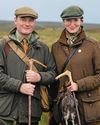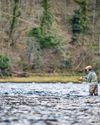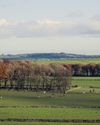
We’ve always had a lot of mountain hares. It’s a success story for us,” said Alex Jenkins, head keeper on the 15,000-acre Edinglassie estate in Upper Donside, Aberdeenshire. Jenkins attributes the flourishing population to two main factors: good habitat and predator control carried out as part of his grouse management. This tallies with the wider picture in North East Scotland, where in spite of their range shrinking nationally, mountain hare numbers are 35 times higher on driven grouse moors compared to unmanaged areas.
In particular, hares benefit from the new heather growth after managed burning. Muirburn plays a vital role in the management of Edinglassie, which is a mix of dry heath and wetter moor at altitudes of up to 2,500ft. Controlled burning is an essential tool to rejuvenate heather moorland, huge swathes of which were lost after World War Two through commercial forestry and over-grazing. In Donside, entire moors were covered in non-native commercial plantations, which support little wildlife. The current trend in the National Park is for planting native woodland and Jenkins is concerned that it might lead to the loss of more heather – and mountain hares with it. “It’s important to remember that the majority of heather cover in the world is found in the UK,” he said. “These moors were designated Sites of Special Scientific Interest (SSSI) because of the habitat and wildlife preserved by grouse shooting, so the traditional management needs to be maintained to keep them in good condition.”
As well as afforestation, moorland suffered from being drained for agriculture in the post-war drive for food production. A common misconception is that this was done for grouse. In fact, the reverse is true and like most grouse moors Edinglassie has been filling in its ditches, creating 150 dams last year alone.
Denne historien er fra March 2020-utgaven av The Field.
Start din 7-dagers gratis prøveperiode på Magzter GOLD for å få tilgang til tusenvis av utvalgte premiumhistorier og 9000+ magasiner og aviser.
Allerede abonnent ? Logg på
Denne historien er fra March 2020-utgaven av The Field.
Start din 7-dagers gratis prøveperiode på Magzter GOLD for å få tilgang til tusenvis av utvalgte premiumhistorier og 9000+ magasiner og aviser.
Allerede abonnent? Logg på

Rory Stewart - The former Cabinet minister and hit podcast host talks to Alec Marsh about the parlous state of British politics, land management and his deep love of the countryside
The gently spoken 51-year-old former Conservative Cabinet minister is a countryman at heart. That's clear: he even changes into a tweed waistcoat for the interview, which takes place at his London home and begins with a question about his precise career status. Having resigned from the Commons and the Conservative Party in 2019, the former diplomat and soldier has reinvented himself, first with an unconventional but promising run as an independent for the London mayoralty (abandoned because of COVID19 in 2020) and then as a media figure, co-hosting one of the country's most popular podcasts, The Rest Is Politics, alongside Alastair Campbell, the former Labour spin doctor.

Fodder
Local fare with the feel-good factor.

Celebrating the game changers
Once served only in the traditional manner, the fruits of our forays now find their way into all manner of diverse and delicious dishes, say Neil and Serena Cross

The first civil engineer
John Smeaton left an indelible mark on the field of engineering and, three centuries after his birth, his legacy remains as strong as ever

School spirits
From grey ladies and ghostly gardeners to more malign entities, public schools are a rich repository of unnatural phenomena

'A long way from Piccadilly or Pall Mall'
Marking 150 years since the birth of Sir Winston Churchill, Dr Conor Farrington explores this eminent statesman’s often-overlooked 1907 tour of British East Africa: a journey rich with enchanting natural beauty and sporting adventure

Top of the pups
Canines in all their guises were celebrated at The Field Top Dog Awards lunch at Defender Burghley Horse Trials whether eager on the peg, patient at home or perpetually making mischief

Angling for success
It’s never too early to shape up for next season’s salmon and trout, and these top fishing schools are here to help

Talking scents
The canine nose is an astonishingly complex piece of biotechnology that man has harnessed for sustenance and sport for thousands of years

Wall-to-wall excitement
Criss-crossed by formidable drystone walls, the High Peak Harriers’ scenic country provides a day out with an exhilarating difference